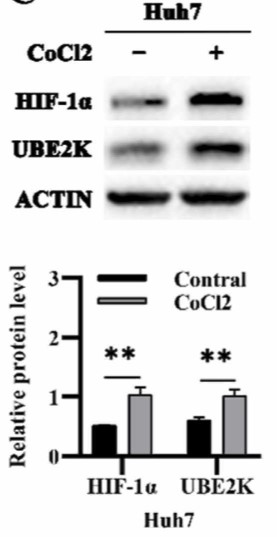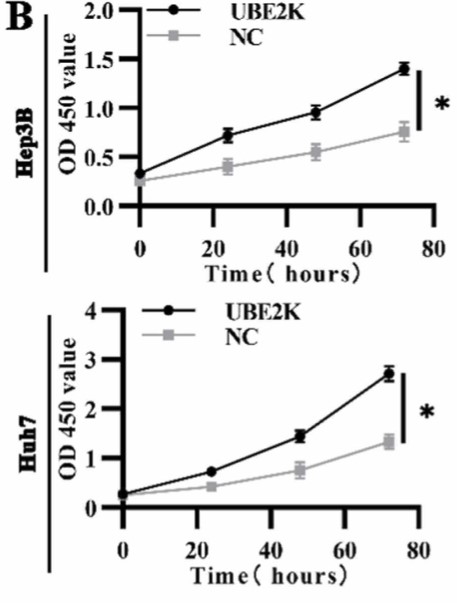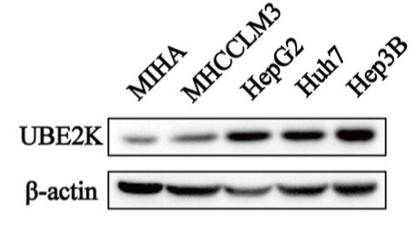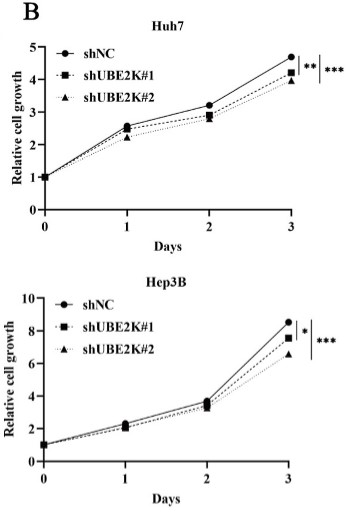UBE2K
-
Official Full Name
ubiquitin-conjugating enzyme E2K -
Overview
The protein encoded by this gene belongs to the ubiquitin-conjugating enzyme family. This protein interacts with RING;finger proteins, and it can ubiquitinate huntingtin, the gene product for Huntingtons disease. Known functions for;this protein include a role in aggregate formation of expanded polyglutamine proteins and the suppression of apoptosis;in polyglutamine diseases, a role in the dislocation of newly synthesized MHC class I heavy chains from the;endoplasmic reticulum, and involvement in foam cell formation. Multiple transcript variants encoding different;isoforms have been identified for this gene. -
Synonyms
UBE2K;ubiquitin-conjugating enzyme E2K;HIP2, huntingtin interacting protein 2 , ubiquitin conjugating enzyme E2K (UBC1 homolog, yeast);ubiquitin-conjugating enzyme E2 K;HYPG;UBC1;HIP-2;E2(25K);ubiquitin-protein ligase;ubiquitin carrier protein
Recombinant Proteins
- Human
- Mouse
- Chicken
- Rhesus macaque
- E.coli
- Mammalian Cells
- Human
- Wheat Germ
- HEK293
- Insect Cells
- In Vitro Cell Free System
- GST
- His
- Non
- Strep
- DDK
- Myc
- Avi
- Fc
Background
What is UBE2K protein?
UBE2K (ubiquitin conjugating enzyme E2 K) gene is a protein coding gene which situated on the short arm of chromosome 4 at locus 4p14. The protein encoded by this gene belongs to the ubiquitin-conjugating enzyme family. This protein interacts with RING finger proteins, and it can ubiquitinate huntingtin, the gene product for Huntington's disease. Known functions for this protein include a role in aggregate formation of expanded polyglutamine proteins and the suppression of apoptosis in polyglutamine diseases, a role in the dislocation of newly synthesized MHC class I heavy chains from the endoplasmic reticulum, and involvement in foam cell formation. The UBE2K protein is consisted of 200 amino acids and its molecular mass is approximately 22.4 kDa.
What is the function of UBE2K protein?
UBE2K is an E2 ubiquitin-conjugating enzyme that accepts ubiquitin from the E1 complex and catalyzes its covalent attachment to other proteins. UBE2K mediates the selective degradation of short-lived and abnormal proteins, such as those involved in endoplasmic reticulum-associated degradation (ERAD) of misfolded lumenal proteins. Research suggests that UBE2K is involved in neurogenesis by regulating the levels of histone H3 and the trimethylation of H3K9, which in turn affects the expression of neurogenic genes in human embryonic stem cells (hESCs). UBE2K interacts with various RING E3 ubiquitin-protein ligases and other proteins, such as huntingtin (HTT), and is involved in the ubiquitination and proteolytic processing of NF-kappa-B. Phosphorylated UBE2K can inhibit p53, leading to the suppression of CDKN1A expression and stimulation of CCND and CCNE, which induce re-entry into the cell cycle.
UBE2K Related Signaling Pathway
As an E2 ubiquitin binding enzyme, UBE2K is involved in the ubiquitination process of proteins, especially the formation of polyubiquitin chains linked by lysine 48 (K48), which is essential for protein degradation. UBE2K is able to interact with a variety of RING domain E3 ubiquitin ligases that are responsible for transferring ubiquitin chains to specific target proteins. In lung adenocarcinoma, UBE2K promotes autophagy through the p53/AMPK/mTOR signaling pathway, affecting cancer cell survival and drug resistance. The interaction of UBE2K's UBA domain with specific ubiquitin chains promotes the selective assembly of the K48/K63 branch ubiquitin conjugate, which is critical for cellular protein homeostasis.
UBE2K Related Diseases
Studies have shown that UBE2K promotes malignant progression of liver cancer by regulating c-Myc. UBE2K is being developed as a target for the modulator drug BRG-399 and is currently in the preclinical stage. UBE2K, in collaboration with MARCH5 E3 ubiquitin ligase, is involved in the regulation of apoptosis processes in AML and may serve as an additional target to enhance the efficacy of venetoclax. UBE2K may be involved in the pathogenesis of neurodegenerative diseases, although the specific mechanism needs further study. UBE2K is associated with the UBR4 E3 ligase, which plays a role in age-related muscle atrophy.
Case Study
Case Study 1: Guangxiong Ouyang, 2023
Hypoxia critically drives malignant tumor development and is characteristic of hepatocellular carcinoma (HCC), where HIF-1α plays a crucial role. The ubiquitin-conjugating enzyme E2K (UBE2K) is known to participate in the advancement of several human cancers. However, the role of UBE2K in HCC or whether it is a hypoxia-responsive gene remains to be further identified. The protein and RNA expression of HIF-1α, UBE2K, and Actin in HCC cells were measured by western blotting(WB) and RT-qPCR, respectively. Immunohistochemical (IHC) staining analyzed the expression of UBE2K and HIF-1α in HCC tissues. Lipofectamine 3000 was used to transfect the plasmids or siRNAs to HCC cells. This study showed that hypoxia induced HIF-1α-mediated increase of UBE2K levels in HCC cells, which decreased under HIF-1α deficiency under hypoxia. Further bioinformatics analysis based on UALCAN and GEPIA databases confirmed that UBE2K was highly expressed in HCC tissues and positively associated with HIF-1α expression. Functionally, Hep3B and Huh7 cell proliferation and migration were stimulated upon UBE2K overexpression, while the UBE2K knockdown suppressed such effect. Furthermore, functional rescue experiment proved that depletion of UBE2K inhibited hypoxia-induced cell proliferation and migration in HCC cells.

Fig1. WB indicates the increased level of UBE2K protein in Huh7 under hypoxia.

Fig2. Upregulation of UBE2K enhanced the proliferative capacity of Hep3B and Huh7.
Case Study 2: Xiangxiang Lei, 2023
Hepatocellular carcinoma (HCC) is a serious threat to human health and life due to its high morbidity and mortality. Ubiquitin-conjugating enzymes are players in the ubiquitin proteasome system and are responsible for a great number of physiological activities in cells. The action of ubiquitin-conjugating enzyme UBE2K in HCC has not been reported. Therefore, the researchers studied the function and role of UBE2K in the malignant progression of HCC. An analysis of UBE2K expression in HCC cells was performed using RT-qPCR and protein immunoblotting. CCK-8, Transwell and sphere formation assays were used to identify the potential effects of UBE2K in HCC cell proliferation, migration and stemness property. RT-qPCR, and protein immunoblotting experiments was taken to explore the regulation between UBE2K and c-Myc. Here, they discovered that UBE2K expression was elevated in HCC cells, and elevated UBE2K predicts worse prognosis for HCC patients. Functionally, UBE2K promote, while UBE2K knockdown suppressed cell proliferation, migration and stemness property of HCC cells. Furthermore, c-Myc was identified as a downstream target of UBE2K. Moreover, functional rescue experiments finally proved that UBE2K facilitates the malignant progression of HCC cells by upregulating c-Myc.

Fig3. UBE2K protein expression in HCC and MIHA cells.

Fig4. CCK-8 assay showed that UBE2K knockdown inhibited the cell viability.
Quality Guarantee
High Purity
.jpg)
Fig1. SDS-PAGE (UBE2K-649H)
.
.jpg)
Fig2. SDS-PAGE (UBE2K-208H)
Involved Pathway
UBE2K involved in several pathways and played different roles in them. We selected most pathways UBE2K participated on our site, such as Ubiquitin mediated proteolysis, which may be useful for your reference. Also, other proteins which involved in the same pathway with UBE2K were listed below. Creative BioMart supplied nearly all the proteins listed, you can search them on our site.
| Pathway Name | Pathway Related Protein |
|---|---|
| Ubiquitin mediated proteolysis | UBE4A,UBE2S,FLJ11011L,UBE2D1,FBXO2,UBE2IA,MID1,SIAH1,KLHL9,UBE2D1A |
Protein Function
UBE2K has several biochemical functions, for example, ATP binding,protein binding,ubiquitin protein ligase binding. Some of the functions are cooperated with other proteins, some of the functions could acted by UBE2K itself. We selected most functions UBE2K had, and list some proteins which have the same functions with UBE2K. You can find most of the proteins on our site.
| Function | Related Protein |
|---|---|
| ubiquitin protein ligase binding | JKAMP,USP2,CALR,C10orf46,PML,UCHL1,RBX1,TNFRSF1B,EGFR,ASB4 |
| ATP binding | AACS,PIP5K2,SRMS,SYK,PRPF4BA,ATP1A1A.3,UBE2J2,STK16,TSSK1,PIP5KL1 |
| protein binding | ALAS2,DIS3L2,TUBGCP2,MAB21L3,ROCK1,TRPM8,MBL2,AJUBA,IRX1,RBMS1 |
| ubiquitin-ubiquitin ligase activity | ANAPC11,UBE4B,PRPF19,AMFR,RBX1,STUB1,PPIL2,UBOX5 |
| ubiquitin-protein transferase activity | NSMCE1,RNF187,NHLRC1,HACE1,RNF168,RCHY1,RNF139,WWP2,UBE2E2,BARD1 |
Interacting Protein
UBE2K has direct interactions with proteins and molecules. Those interactions were detected by several methods such as yeast two hybrid, co-IP, pull-down and so on. We selected proteins and molecules interacted with UBE2K here. Most of them are supplied by our site. Hope this information will be useful for your research of UBE2K.
SIAH1;RNF138;REL;DTX3;MIPOL1;DDI1
Resources
Research Area
ALS Related MoleculesParkinson's Disease Related Molecules
E2 Ubiquitin/Ubl Conjugating Enzymes
Related Services
Related Products
References
- Rajsbaum, R; Versteeg, GA; et al. Unanchored K48-Linked Polyubiquitin Synthesized by the E3-Ubiquitin Ligase TRIM6 Stimulates the Interferon-IKK epsilon Kinase-Mediated Antiviral Response. IMMUNITY 40:880-895(2014).
- Filatova, EV; Shadrina, MI; et al. Expression analysis of genes of ubiquitin-proteasome protein degradation system in MPTP-induced mice models of early stages of Parkinson's disease. DOKLADY BIOCHEMISTRY AND BIOPHYSICS 456:116-118(2014).


